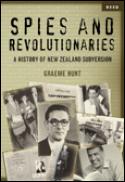Graeme Hunt's Book on New Zealand Spies and Revolutionaries – Chapter Five: Red wreckers and fellow travellers
Scoop is serializing the first 1000 words of each chapter of author Graeme Hunt's latest book: Spies And Revolutionaries – A History of New Zealand Subversion. Click here for Chapter Five: Red wreckers and fellow travellers
 The history of New Zealand's intelligence agencies and
those it has spied on have been laid bare in a book by
Auckland-based journalist, author, and historian Graeme
Hunt.
The history of New Zealand's intelligence agencies and
those it has spied on have been laid bare in a book by
Auckland-based journalist, author, and historian Graeme
Hunt.
Spies And Revolutionaries – A History of New Zealand Subversion details how several prominent New Zealanders, all of whom are dead, spied for the former Soviet Union during the Cold War. Accusations and suspicions are laid bare before files and information that has never before been made public. This book will clearly recharge debate as to whether Dr Bill Sutch, diplomat Paddy Costello, and public servant Ian Milner were spies acting against New Zealand's national interest.
CHAPTER FIVE: Red wreckers and fellow travellers
 Prime Minister Bill Massey had long talked about ‘Russian
Bolshevik’ supporters planning to disrupt New Zealand life
but it was not until August 1925, three months after his
death, that the country’s industrial Marxists showed their
hand in earnest. An unofficial strike by British seamen
opposed to the UK National Maritime Board’s imposition of
a series of wage cuts seemed to confirm the Reform
government’s worst fears of the ‘red wreckers’ at work
in New Zealand. But the home boat strike, as it was called,
which affected ports throughout the British Empire, was as
much an internal union battle as a Moscow-orchestrated
attack on imperial trade.
Prime Minister Bill Massey had long talked about ‘Russian
Bolshevik’ supporters planning to disrupt New Zealand life
but it was not until August 1925, three months after his
death, that the country’s industrial Marxists showed their
hand in earnest. An unofficial strike by British seamen
opposed to the UK National Maritime Board’s imposition of
a series of wage cuts seemed to confirm the Reform
government’s worst fears of the ‘red wreckers’ at work
in New Zealand. But the home boat strike, as it was called,
which affected ports throughout the British Empire, was as
much an internal union battle as a Moscow-orchestrated
attack on imperial trade.
The wage cuts, akin to those suffered by the Federated Seamen’s Union of New Zealand in 1922, had been approved, albeit reluctantly, by the National Sailors’ & Firemen’s Union of Great Britain & Ireland and its leader, Havelock Wilson. But the communist Militant Minority Movement, which had a fraction1 in the British union, refused to accept them and organised an international strike to tie up the UK merchant fleet. Officials in the Federated Seamen’s Union sympathised with the strikers but were reluctant to buck the policy of the British union, so it fell to militant Marxist seamen like F.P. Walsh and Peter Butler to take up the strikers’ cause and dissuade unemployed New Zealand seamen from working on the strike-bound ships.
Walsh had quit the Communist Party a year earlier but still headed the Marxist group in the Federated Seamen’s Union. Butler, like Walsh a lapsed Catholic and a Sinn Féiner, was still a card-carrying communist. Using a mixture of debate, coercion and intimidation, the pair rallied local support for the strikers and ensured that no New Zealand unionist offered himself for a striker’s job. The strike collapsed after two months but Walsh and Butler, especially the former, were the real beneficiaries. They had demonstrated the power of direct action and the ability of New Zealand seamen to embrace working-class solidarity across international borders.
The strike was a direct challenge to Massey’s successor, Gordon Coates, who portrayed it in the general election campaign in October–November 1925 as the handiwork of international communism. A Reform Party election advertisement showed a bearded Russian communist with the Red Flag behind him pulling Britain and New Zealand’s lifelines. It also asked why the New Zealand Labour Party had not condemned the home boat strike which, it claimed, was ‘directly ordered from Moscow through paid agents in Britain and the Dominions’ –– an oblique reference to Walsh and Butler’s Marxist group in the Federated Seamen’s Union. The mastermind, according to Reform, was Leon Trotsky, the Soviet Union’s recently deposed people’s commissar of army and fleet affairs.
Like Massey, Coates continued to link communism with parliamentary Labour. This was despite the fact Labour had mellowed politically since the end of World War I and, at its conference in Easter 1925, had voted to deny party membership to anyone belonging to another party –– a move aimed specifically at the communists. Unwittingly, that action served only to reinforce a tenet of Leninism, namely that communist accommodation with social democratic parties –– so called ‘popular fronts’ –– was a crime.2
Massey had been especially concerned at the growing influence of the Communist Party of Australia on its weaker New Zealand counterpart. He saw this radicalism from across the Tasman as a trend dating back to pre-war industrial militancy, the creation of the Red Feds and the formation of the Labour Party. To be sure, Australians, especially Australian Catholics, counted strongly among New Zealand’s early social revolutionaries, but equally New Zealand had produced radicals of her own who made their name in Australia and beyond.
When communist organiser Hector Ross arrived from Australia in December 1924 to reinvigorate the Communist Party of New Zealand, he attracted police attention, in part because he was accompanied by his New Zealand-born wife, Hetty (née Weitzel), who had fallen foul of the New Zealand authorities in 1921. Her prosecution then for selling seditious literature was the talk of Wellington, partly because she was the daughter of German socialists and anti-militarists3 who were known to the police during the war.
Weitzel had completed her bachelor of arts degree at Victoria University College in 1920 and enrolled as a teacher-trainee at Wellington Teachers’ Training College the following year. She also joined the New Zealand Socialist Party in 1921, which soon was absorbed into the Communist Party of New Zealand, and she was appointed the party’s literature secretary for Wellington. But her teacher training came to an abrupt end when she sold a copy of a proscribed Australian journal, the Communist, to an undercover policeman in June 1921. She was prosecuted under the War Regulations Continuance Act, fined £10 and soon after expelled from the training college.
When a group of students helped pay Weitzel’s fine, Education Minister James Parr launched an inquiry into ‘communist influence’ at the training college and Victoria University College. The inquiry found little evidence of radicalism but Weitzel was unable to continue her teacher training, not least because of Parr’s introduction of a loyalty pledge for New Zealand teachers. Weitzel, reputedly a girlfriend of F.P. Walsh, went to Australia in 1922 where she met and married Ross, a member of the Communist Party of Australia’s central committee.
Weitzel also joined the central committee and she and Ross edited the communist newspaper, the Workers’ Weekly, for a period. She later became a leading feminist and a prominent trade unionist in the teaching profession. But she was not the only New Zealand woman to shine in the Communist Party of Australia. Novelist Jean Devanny moved with her husband Hal to Australia in 1929. She joined the Australian party two years later and soon made her mark. But she was expelled from the party in 1941 on the questionable charges of moral degeneracy and disobeying an order but was readmitted in 1944 only to leave the party again in 1950. Like Weitzel, Devanny was a feminist and an advocate of sexual freedom and her marriage to Hal had ended in 1931, the year Weitzel and Hector Ross divorced.
See Also:
Scoop is serializing the first 1000 words of each chapter of author Graeme Hunt's latest book: Spies And Revolutionaries – A History of New Zealand Subversion.
SRP: $29.99
ISBN:
9780790011400
340p, includes index, black and white
photos
Reed Publishing (NZ) Ltd www.reed.co.nz
Release: August 6 2007
For more, see… Reed Publishers, Spies And
Revolutionaries



 Keith Rankin: Equity Rights - UBI, SUI, BUI, HUI, Or GUI?
Keith Rankin: Equity Rights - UBI, SUI, BUI, HUI, Or GUI? Binoy Kampmark: The Inevitable Souring - Elon Musk Falls Out With Donald Trump
Binoy Kampmark: The Inevitable Souring - Elon Musk Falls Out With Donald Trump Ian Powell: Postscript On Ethnic Cleansing, Genocide And New Zealand Recognition Of Palestine
Ian Powell: Postscript On Ethnic Cleansing, Genocide And New Zealand Recognition Of Palestine Gordon Campbell: On Why Leakers Are Essential To The Public Good
Gordon Campbell: On Why Leakers Are Essential To The Public Good Ramzy Baroud: Global Backlash - How The World Could Shift Israel's Gaza Strategy
Ramzy Baroud: Global Backlash - How The World Could Shift Israel's Gaza Strategy DC Harding: In The Spirit Of Natural Justice
DC Harding: In The Spirit Of Natural Justice